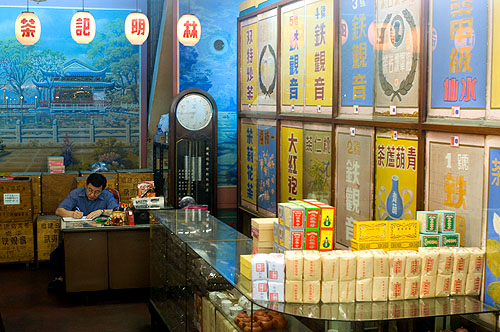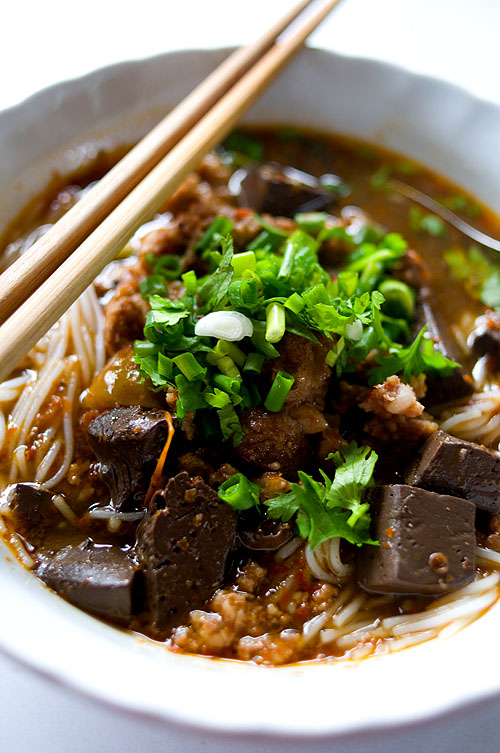 It's been far too long and I apologize. I've been working furiously on the next edition of Lonely Planet's Thailand, and simply haven't had the time to blog. I am in Chiang Rai at the moment, doing research for Thailand, and will do my best to share the food discoveries I've been making up here.
It's been far too long and I apologize. I've been working furiously on the next edition of Lonely Planet's Thailand, and simply haven't had the time to blog. I am in Chiang Rai at the moment, doing research for Thailand, and will do my best to share the food discoveries I've been making up here.
Guided by an old issue of the Thai-language food magazine Khrua, my first great food find here in Chiang Rai is a local noodle restaurant called Paa Suk.

The signature dish here is naam ngiaw, a thin broth (usually pork, but here they also do a beef version) flavoured with a local chili paste and tomatoes, typically served over fresh khanom jeen noodles ('northern spaghetti', if you will) . The pork version (pictured at the top of this post) was deliciously meaty, although I personally prefer the type served in Mae Hong Son that emphasizes sour tomatoes over meat. The dark cubes you see are coagulated blood, and the dish is served with sides of bean sprouts, pickled mustard cabbage and slices of lime.
They also do a very northern dish called khao kan jin:

This is rice that has been mixed with (again) blood, wrapped in a banana leaf, then steamed. The result is drizzled with garlic oil and served with fresh coriander, cucumber and green onion. Very nice, and you wouldn't know there was blood involved unless I told you.
The restaurant is currently being run by the third generation of the same family, and now they even have a branch on Soi 3, Th Silom, in Bangkok, which I'll be sure to investigate as soon as I get back.
Paa Suk Th Sankhongnoi, Chiang Rai 053 752 471 7am-3pm












 After many, many visits to Bangkok's Chinatown in the last year, my seemingly aimless wanderings have culminated in this; beginning on December 6th, 15 of the images I captured there will be exhibited at Kathmandu, the Bangkok photography gallery owned by famed Thai photographer, Manit Sriwanichpoom. The official press release:
After many, many visits to Bangkok's Chinatown in the last year, my seemingly aimless wanderings have culminated in this; beginning on December 6th, 15 of the images I captured there will be exhibited at Kathmandu, the Bangkok photography gallery owned by famed Thai photographer, Manit Sriwanichpoom. The official press release: Jay is the Chinese/Thai word for vegetarian, and from now until October 9th is the annual Ngaan Jay, Vegetarian Festival. To be honest though, it is quite possibly the most innacurately-named festival around. Although everything for sale in Thailand's various Chinese districts during this period is entirely meat free, you'll actually find very few, if any, actual vegetables. Just about everything is either some form of starch (noodles, rice, potatoes) or protein (soy).
Jay is the Chinese/Thai word for vegetarian, and from now until October 9th is the annual Ngaan Jay, Vegetarian Festival. To be honest though, it is quite possibly the most innacurately-named festival around. Although everything for sale in Thailand's various Chinese districts during this period is entirely meat free, you'll actually find very few, if any, actual vegetables. Just about everything is either some form of starch (noodles, rice, potatoes) or protein (soy).





 It's that time of year again: Thailand's annual Vegetarian Festival is in full swing, and as always, the best place to eat is the Chinatown area. Most people come for the various meat-free noodle and fried dishes, but I personally can't wait for khanom tup tap. This is an old-school snack made from peanuts, sugar and a bit of salt pounded into a flaky roll--via a pretty amazing process.
It's that time of year again: Thailand's annual Vegetarian Festival is in full swing, and as always, the best place to eat is the Chinatown area. Most people come for the various meat-free noodle and fried dishes, but I personally can't wait for khanom tup tap. This is an old-school snack made from peanuts, sugar and a bit of salt pounded into a flaky roll--via a pretty amazing process.
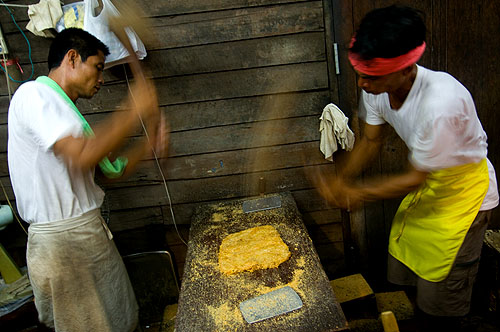
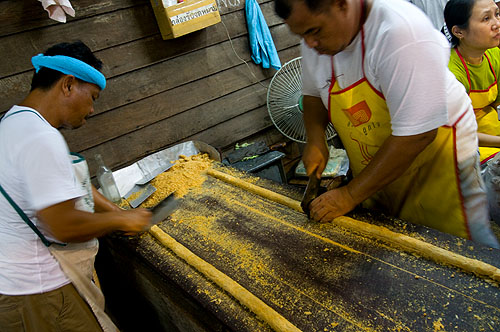
 Kuay jap, a thick broth with deep-fried crispy pork, pork offal and thick noodles is not a dish I thought I would like. In general, I try to keep my meat consumption to a minium, and I like noodles well enough, but rarely crave them. However with kuay jap it's the broth that keeps drawing me back... The thick liquid is so laden with pepper that it's positively spicy.
Kuay jap, a thick broth with deep-fried crispy pork, pork offal and thick noodles is not a dish I thought I would like. In general, I try to keep my meat consumption to a minium, and I like noodles well enough, but rarely crave them. However with kuay jap it's the broth that keeps drawing me back... The thick liquid is so laden with pepper that it's positively spicy.
 I've eaten at many, if not most of the upscale Thai restaurants in Bangkok, and have rarely, if ever, had a good meal. Nothing I ate at these restaurants was necessarily bad--no hairs were found, no surly service, nothing rotten--but rather, the food left no impression whatsoever. The general phenomenon seems to be that the more you pay for Thai food, the less flavourful it is, and the more predictable the menu tends to be.
I've eaten at many, if not most of the upscale Thai restaurants in Bangkok, and have rarely, if ever, had a good meal. Nothing I ate at these restaurants was necessarily bad--no hairs were found, no surly service, nothing rotten--but rather, the food left no impression whatsoever. The general phenomenon seems to be that the more you pay for Thai food, the less flavourful it is, and the more predictable the menu tends to be.


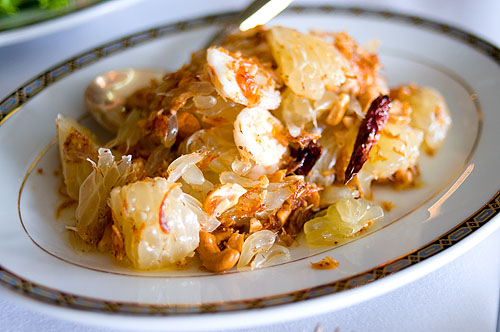


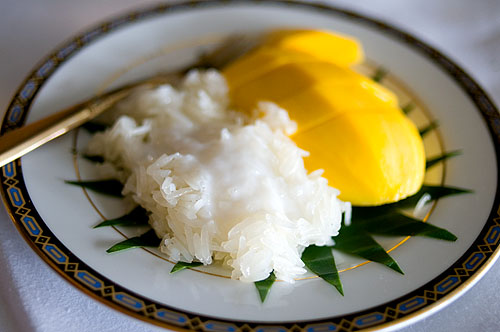
 If you're hungry, in Bangkok, and don't happen to have any money, I'd suggest stopping by Government House. At the moment there's a crazy party going on there with heaps of free nosh:
If you're hungry, in Bangkok, and don't happen to have any money, I'd suggest stopping by Government House. At the moment there's a crazy party going on there with heaps of free nosh:


 It's been a while since I've featured any recipes on these pages, and unfortunately, I'm not sure when I'll get a chance to do that anytime soon. Luckily, thanks to
It's been a while since I've featured any recipes on these pages, and unfortunately, I'm not sure when I'll get a chance to do that anytime soon. Luckily, thanks to 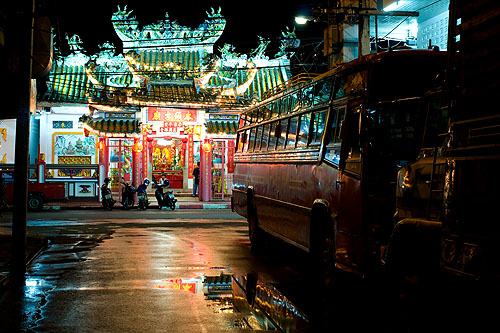 A Chinese temple in Phitsanulok. I like the colours and the reflection of light off the puddles and the bus.
A Chinese temple in Phitsanulok. I like the colours and the reflection of light off the puddles and the bus. Noodles are ubiquitous across all of Thailand, but they often take slightly different forms depending on where in the country you are. I was surprised to find quite a few different kinds of noodles on my recent trip up north. Of course, there's the famous khao soi:
Noodles are ubiquitous across all of Thailand, but they often take slightly different forms depending on where in the country you are. I was surprised to find quite a few different kinds of noodles on my recent trip up north. Of course, there's the famous khao soi:





 In addition to the
In addition to the 
 Several months' work has finally taken a tangible form. Lonely Planet's Bangkok, which I co-authored with Andrew Burke, and Thailand's Islands & Beaches, of which I wrote several chapters including Food, have finally been printed.
Several months' work has finally taken a tangible form. Lonely Planet's Bangkok, which I co-authored with Andrew Burke, and Thailand's Islands & Beaches, of which I wrote several chapters including Food, have finally been printed. A performer waiting to go onstage at a likay performance, Kamphaeng Phet.
A performer waiting to go onstage at a likay performance, Kamphaeng Phet. 






 I've been in northern Thailand for two weeks now, but Lampang is as far north as I've made it. As one goes further south within phaak nuea (northern Thailand), the language, culture and food become more like those of central Thailand, so Lampang was really my only chance to get my hands on good, authentic northern-style Thai food.
I've been in northern Thailand for two weeks now, but Lampang is as far north as I've made it. As one goes further south within phaak nuea (northern Thailand), the language, culture and food become more like those of central Thailand, so Lampang was really my only chance to get my hands on good, authentic northern-style Thai food.



 Definitely an pic that requires a bit of explanation...
Definitely an pic that requires a bit of explanation...

 Guess it wasn't that important of a prayer.
Guess it wasn't that important of a prayer.
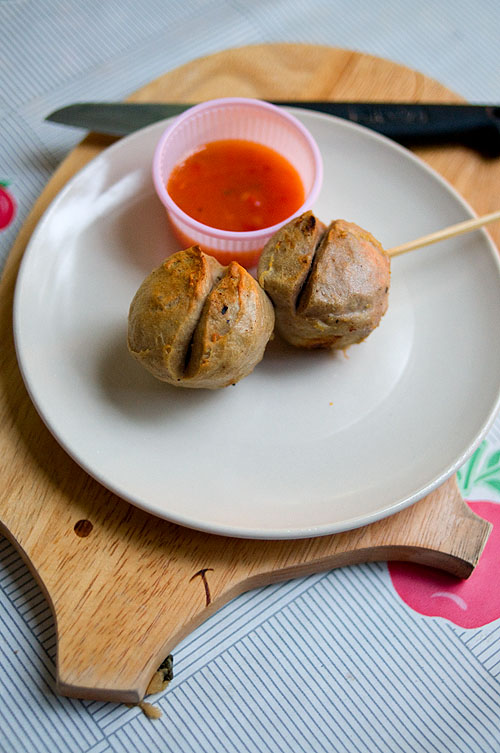 It was at Lampang's night market that I first came across look chin khiang, 'cutting board meatballs' (shown above). Several vendors were selling them, and just about everybody was eating them. Initially I was impressed by their size--roughly equivalent to a child's fist. But I also really loved how they were served. After being grilled:
It was at Lampang's night market that I first came across look chin khiang, 'cutting board meatballs' (shown above). Several vendors were selling them, and just about everybody was eating them. Initially I was impressed by their size--roughly equivalent to a child's fist. But I also really loved how they were served. After being grilled:
 Khun Manee is a respected maker of khao taen (pictured above), rice cakes that are deep-fried and drizzled with palm sugar, in Lampang, a city in northern Thailand that is known for the sweet.
Khun Manee is a respected maker of khao taen (pictured above), rice cakes that are deep-fried and drizzled with palm sugar, in Lampang, a city in northern Thailand that is known for the sweet.



 Am currently in northern Thailand, where khao soi (pictured above) has been flowing through my veins for the last few days. Will follow up soon with exciting, action-packed dispatches from Lampang, Sukhothai and elsewhere...
Am currently in northern Thailand, where khao soi (pictured above) has been flowing through my veins for the last few days. Will follow up soon with exciting, action-packed dispatches from Lampang, Sukhothai and elsewhere... A resident of Bangkok's Chinatown in front of his home
A resident of Bangkok's Chinatown in front of his home


